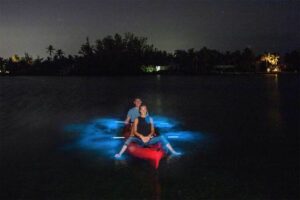Exploring the Enchantment of Vieques: Your Guide to Getting There, Visiting Bioluminescent Bay, and Embracing the Weather
Puerto Rico is a tropical paradise that beckons travelers from around the globe, but few places are as magical as Vieques. This small island, located just off the eastern coast of Puerto Rico, is home to stunning beaches, rich history, and one of nature’s most spectacular phenomena: the bioluminescent bays. In this article, we’ll explore how to get to Vieques, when to visit the enchanting Bioluminescent Bay, and what to expect from the island’s weather—all while highlighting the exceptional services offered by Tropical Reef Watersport.
How Do You Get to Vieques?
Getting to Vieques is a breeze, whether you prefer flying or taking a ferry. Here’s a breakdown of your travel options:
By Air
The quickest way to reach Vieques is by air. Several airlines offer short flights from San Juan’s Isla Grande Airport (SIG) or Luis Muñoz Marín International Airport (SJU) directly to Vieques. The flight takes about 25 minutes, providing stunning views of the Caribbean Sea and the surrounding islands. Once you arrive at Antonio Rivera Rodríguez Airport (VQS), you’ll find yourself just a short drive from the island’s main attractions.
By Ferry
If you prefer a more scenic route, consider taking the ferry from Ceiba on the mainland of Puerto Rico. The ferry ride lasts approximately 45 minutes and offers beautiful views of the coastline. Ferries run multiple times daily, but it’s wise to check the schedule in advance and arrive early to secure your spot.
Local Transportation
Once you arrive in Vieques, getting around is easy. You can rent a car or scooter, take a taxi, or use local transportation services. Tropical Reef Watersport provides convenient pick-up services for their tours, ensuring that your journey to Mosquito Bay is seamless and enjoyable.
When Should You Go to Bioluminescent Bay?
The best time to visit Mosquito Bay—the brightest bioluminescent bay in the world—is between late spring and early fall. This period typically spans from May to October, when the water temperatures are warmer and the dinoflagellates (the tiny organisms responsible for the glow) are most active.
Optimal Conditions for Viewing
For an unforgettable experience in Mosquito Bay, timing your visit around a new moon is essential. During this phase, the sky is darker, allowing for maximum visibility of the bioluminescence. Avoid scheduling your trip during full moon nights or within five days before and after it; this will ensure that you witness the stunning glow at its brightest.
Seasonal Highlights
- Summer Months (June – August): These months are peak season for bioluminescence. The warm waters and active dinoflagellates create ideal conditions for glowing displays.
- Fall (September – October): As summer fades into fall, conditions remain favorable for viewing bioluminescence. Additionally, there are often fewer tourists during this time.
- Winter (December – February): While you can still see bioluminescence during winter months, be aware that colder temperatures may affect water activity.
Booking with Tropical Reef Watersport
Tropical Reef Watersport offers guided kayak tours through Mosquito Bay that allow you to experience this natural wonder up close. Their knowledgeable guides will lead you through the bay while sharing fascinating information about its ecology and history. With small group sizes and personalized service, you’re guaranteed an intimate experience in one of nature’s most breathtaking settings.
What’s the Weather Like in Vieques?
The weather in Vieques is typically warm and inviting year-round, making it an ideal destination for beach lovers and adventure seekers alike.
General Climate Overview
- Temperature: Average temperatures range from 70°F (21°C) at night to 85°F (29°C) during the day.
- Humidity: Being a tropical island, humidity levels can be high; however, ocean breezes help keep things comfortable.
- Rainfall: The rainy season runs from May through October, with September being the wettest month. Despite occasional showers, rain typically comes in short bursts followed by sunshine.
Best Times to Visit
- Dry Season (December – April): This period features less rainfall and more sunshine—perfect for outdoor activities like kayaking and snorkeling.
- Shoulder Season (May – June): Early summer offers warm weather with fewer crowds before peak tourist season kicks in.
- Hurricane Season (June – November): While hurricanes can occur during these months, they are relatively rare. It’s still possible to enjoy your visit; just keep an eye on weather forecasts.
Packing Tips
When visiting Vieques, pack light clothing suitable for warm weather—think shorts, t-shirts, swimsuits, and sandals. Don’t forget sunscreen (reef-safe), insect repellent (to protect against mosquitoes), and a light jacket for cooler evenings.
Embrace Adventure with Tropical Reef Watersport
Tropical Reef Watersport is your go-to provider for exploring Vieques’ stunning natural beauty. In addition to their famous bioluminescent bay tours, they offer a variety of exciting activities:
- Kayaking Tours: Paddle through calm waters while marveling at the vibrant marine life.
- Jetski Rentals: Experience the thrill of racing across crystal-clear waters at your own pace.
- Snorkeling Adventures: Discover colorful coral reefs teeming with tropical fish in some of Puerto Rico’s best snorkeling spots.
Their commitment to excellent customer service ensures that every aspect of your adventure is enjoyable and memorable. Whether you’re a seasoned adventurer or trying something new for the first time, Tropical Reef Watersport has something for everyone.
Vieques is a hidden gem waiting to be explored. With its breathtaking bioluminescent bays, warm tropical climate, and endless opportunities for adventure, it’s no wonder travelers flock here year-round. By planning your trip carefully—considering how to get there, when to visit Mosquito Bay for optimal viewing conditions, and what weather to expect—you’re setting yourself up for an unforgettable experience.Tropical Reef Watersport stands ready to help you make the most of your journey through this enchanting island paradise. So pack your bags and get ready for an adventure filled with glowing waters and beautiful memories! 🌊✨






